Chevrolet Impala 2014, Impala Limited Police 2014 Owner's Manual

2014 Chevrolet Impala Owner Manual M
In Brief . . . . . . . . . . . . . . . . . . . . . . . . 1-1
Instrument Panel . . . . . . . . . . . . . . 1-2
Initial Drive Information . . . . . . . . 1-4
Vehicle Features . . . . . . . . . . . . . 1-18
eAssist Features . . . . . . . . . . . . . 1-23
Performance and
Maintenance . . . . . . . . . . . . . . . . 1-25
Keys, Doors, and
Windows . . . . . . . . . . . . . . . . . . . . 2-1
Keys and Locks . . . . . . . . . . . . . . . 2-1
Doors . . . . . . . . . . . . . . . . . . . . . . . . 2-14
Vehicle Security. . . . . . . . . . . . . . 2-16
Exterior Mirrors . . . . . . . . . . . . . . . 2-19
Interior Mirrors . . . . . . . . . . . . . . . . 2-20
Windows . . . . . . . . . . . . . . . . . . . . . 2-21
Roof . . . . . . . . . . . . . . . . . . . . . . . . . . 2-23
Seats and Restraints . . . . . . . . . 3-1
Head Restraints . . . . . . . . . . . . . . . 3-2
Front Seats . . . . . . . . . . . . . . . . . . . . 3-4
Rear Seats . . . . . . . . . . . . . . . . . . . 3-11
Safety Belts . . . . . . . . . . . . . . . . . . 3-13
Airbag System . . . . . . . . . . . . . . . . 3-20
Child Restraints . . . . . . . . . . . . . . 3-34
Storage . . . . . . . . . . . . . . . . . . . . . . . 4-1
Storage Compartments . . . . . . . . 4-1
Additional Storage Features . . . 4-3
Instruments and Controls . . . . 5-1
Controls . . . . . . . . . . . . . . . . . . . . . . . 5-2
Warning Lights, Gauges, and
Indicators . . . . . . . . . . . . . . . . . . . . 5-8
Information Displays . . . . . . . . . . 5-26
Vehicle Messages . . . . . . . . . . . . 5-30
Vehicle Personalization . . . . . . . 5-40
Universal Remote System . . . . 5-46
Lighting . . . . . . . . . . . . . . . . . . . . . . . 6-1
Exterior Lighting . . . . . . . . . . . . . . . 6-1
Interior Lighting . . . . . . . . . . . . . . . . 6-4
Lighting Features . . . . . . . . . . . . . . 6-5
Infotainment System . . . . . . . . . 7-1
Introduction . . . . . . . . . . . . . . . . . . . . 7-1
Radio . . . . . . . . . . . . . . . . . . . . . . . . . . 7-7
Audio Players . . . . . . . . . . . . . . . . 7-12
Phone . . . . . . . . . . . . . . . . . . . . . . . . 7-18
Trademarks and License
Agreements . . . . . . . . . . . . . . . . . 7-29
Climate Controls . . . . . . . . . . . . . 8-1
Climate Control Systems . . . . . . 8-1
Air Vents . . . . . . . . . . . . . . . . . . . . . . . 8-7
Maintenance . . . . . . . . . . . . . . . . . . . 8-8
Driving and Operating . . . . . . . . 9-1
Driving Information . . . . . . . . . . . . . 9-2
Starting and Operating . . . . . . . 9-15
Engine Exhaust . . . . . . . . . . . . . . 9-26
Automatic Transmission . . . . . . 9-27
Brakes . . . . . . . . . . . . . . . . . . . . . . . 9-30
Ride Control Systems . . . . . . . . 9-33
Cruise Control . . . . . . . . . . . . . . . . 9-35
Driver Assistance Systems . . . 9-45
Fuel . . . . . . . . . . . . . . . . . . . . . . . . . . 9-56
Towing . . . . . . . . . . . . . . . . . . . . . . . 9-61
Conversions and Add-Ons . . . 9-66
Vehicle Care . . . . . . . . . . . . . . . . . 10-1
General Information . . . . . . . . . . 10-2
Vehicle Checks . . . . . . . . . . . . . . . 10-3
Headlamp Aiming . . . . . . . . . . . 10-30
Bulb Replacement . . . . . . . . . . 10-31
Electrical System . . . . . . . . . . . . 10-35
Wheels and Tires . . . . . . . . . . . 10-42
Jump Starting . . . . . . . . . . . . . . . 10-71

2014 Chevrolet Impala Owner Manual M
Towing the Vehicle . . . . . . . . . . 10-75
Appearance Care . . . . . . . . . . . 10-77
Service and Maintenance . . . 11-1
General Information . . . . . . . . . . 11-1
Maintenance Schedule . . . . . . . 11-2
Special Application
Services . . . . . . . . . . . . . . . . . . . . 11-8
Additional Maintenance
and Care . . . . . . . . . . . . . . . . . . . . 11-9
Recommended Fluids,
Lubricants, and Parts . . . . . . 11-12
Maintenance Records . . . . . . . 11-15
Technical Data . . . . . . . . . . . . . . . 12-1
Vehicle Identification . . . . . . . . . 12-1
Vehicle Data . . . . . . . . . . . . . . . . . . 12-2
Customer Information . . . . . . . 13-1
Customer Information . . . . . . . . 13-1
Reporting Safety Defects . . . . 13-12
Vehicle Data Recording and
Privacy. . . . . . . . . . . . . . . . . . . . 13-13
OnStar . . . . . . . . . . . . . . . . . . . . . . . 14-1
OnStar Overview. . . . . . . . . . . . . 14-1
OnStar Services . . . . . . . . . . . . . . 14-2
OnStar Additional
Information . . . . . . . . . . . . . . . . . . 14-5
Index . . . . . . . . . . . . . . . . . . . . . i-1

Introduction iii
The names, logos, emblems, slogans, vehicle model names, and vehicle body designs appearing in this manual including, but not limited to, GM, the GM logo, CHEVROLET, the CHEVROLET Emblem, IMPALA, and the IMPALA Emblem are trademarks and/or service marks of General Motors LLC, its subsidiaries, affiliates, or licensors.
This manual describes features that may or may not be on your specific vehicle either because they are options that you did not purchase or due to changes subsequent to the printing of this owner manual. Please refer to the purchase documentation relating to your specific vehicle to confirm each of the features found on your vehicle. For vehicles first sold in Canada, substitute the name "General Motors of Canada Limited" for Chevrolet Motor Division wherever it appears in this manual.
Keep this manual in the vehicle for quick reference.
Canadian Vehicle Owners
Propriétaires Canadiens
A French language manual can be obtained from your dealer, at www.helminc.com, or from:
On peut obtenir un exemplaire de ce guide en français auprès du concessionnaire ou à l'adresse savant:
Helm, Incorporated
Attention: Customer Service
47911 Halyard Drive
Plymouth, MI 48170
Using this Manual
To quickly locate information about the vehicle, use the Index in the back of the manual. It is an alphabetical list of what is in the manual and the page number where it can be found.
Litho in U.S.A. |
© 2014 General Motors LLC. All Rights Reserved. |
Part No. 22825342 C Third Printing |

iv Introduction
Danger, Warnings, and
Cautions
{Danger
Text marked { Danger provides information on risk of fatal injury. Disregarding this information may endanger life.
{Warning
Text marked { Warning provides information on risk of accident or injury. Disregarding this information may lead to injury.
{Caution
Text marked { Caution provides information that may indicate a hazard that could result in injury or death. It could also result in possible damage to the vehicle.
A circle with a slash through it is a safety symbol which means “Do Not,” “Do not do this,” or “Do not let this happen.”
Symbols
The vehicle has components and labels that use symbols instead of text. Symbols are shown along with the text describing the operation or
information relating to a specific component, control, message, gauge, or indicator.
M : This symbol is shown when you need to see your owner manual for additional instructions or information.
* : This symbol is shown when you need to see a service manual for additional instructions or information.
Vehicle Symbol Chart
Here are some additional symbols that may be found on the vehicle and what they mean. For more information on the symbol, refer to the Index.
9 : Airbag Readiness Light
G : Air Conditioning Refrigerant Oil
! : Antilock Brake System (ABS)
g : Audio Steering Wheel Controls or OnStar®
$ : Brake System Warning Light

Introduction v
" : Charging System
I : Cruise Control
B : Engine Coolant Temperature
O : Exterior Lamps
g: First Responder
. : Fuel Gauge
+ : Fuses
3 : Headlamp High/Low-Beam
Changer
( : Heated Steering Wheel
j : LATCH System Child
Restraints
* : Malfunction Indicator Lamp
: : Oil Pressure
O : Power
/ : Remote Vehicle Start
> : Safety Belt Reminders
7 : Tire Pressure Monitor
d : Traction Control/StabiliTrak®
M : Windshield Washer Fluid

vi Introduction
2 NOTES

In Brief |
1-1 |
In Brief
Instrument Panel
Instrument Panel . . . . . . . . . . . . . . 1-2
Initial Drive Information
Initial Drive Information . . . . . . . . 1-4
Remote Keyless Entry (RKE)
System . . . . . . . . . . . . . . . . . . . . . . 1-4
Remote Vehicle Start . . . . . . . . . 1-5
Door Locks . . . . . . . . . . . . . . . . . . . 1-6
Trunk . . . . . . . . . . . . . . . . . . . . . . . . . 1-7
Windows . . . . . . . . . . . . . . . . . . . . . . 1-7
Seat Adjustment . . . . . . . . . . . . . . 1-8
Memory Features . . . . . . . . . . . . 1-10
Second Row Seats . . . . . . . . . . 1-10
Heated and Ventilated
Seats . . . . . . . . . . . . . . . . . . . . . . . 1-11
Head Restraint
Adjustment . . . . . . . . . . . . . . . . . 1-11
Safety Belts . . . . . . . . . . . . . . . . . . 1-11
Passenger Sensing
System . . . . . . . . . . . . . . . . . . . . . 1-12
Mirror Adjustment . . . . . . . . . . . . 1-12
Steering Wheel
Adjustment . . . . . . . . . . . . . . . . . 1-13
Interior Lighting . . . . . . . . . . . . . . 1-13
Exterior Lighting . . . . . . . . . . . . . 1-14
Windshield Wiper/Washer . . . . 1-15
Climate Controls . . . . . . . . . . . . . 1-16
Transmission . . . . . . . . . . . . . . . . 1-17
Vehicle Features
Radio(s) . . . . . . . . . . . . . . . . . . . . . 1-18
Satellite Radio . . . . . . . . . . . . . . . 1-18
Portable Audio Devices . . . . . . 1-18
Bluetooth® . . . . . . . . . . . . . . . . . . . 1-19
Steering Wheel Controls . . . . . 1-19
Cruise Control . . . . . . . . . . . . . . . 1-20
Infotainment System . . . . . . . . . 1-20
Driver Information
Center (DIC) . . . . . . . . . . . . . . . 1-20
Forward Collision Alert (FCA)
System . . . . . . . . . . . . . . . . . . . . . 1-21
Lane Departure
Warning (LDW) . . . . . . . . . . . . . 1-21
Side Blind Zone
Alert (SBZA) . . . . . . . . . . . . . . . 1-21
Rear Vision
Camera (RVC) . . . . . . . . . . . . . 1-21
Ultrasonic Parking Assist . . . . 1-21
Power Outlets . . . . . . . . . . . . . . . 1-22
Universal Remote System . . . 1-22
Sunroof . . . . . . . . . . . . . . . . . . . . . . 1-22
eAssist Features
eAssist® Overview . . . . . . . . . . . 1-23
High Voltage Safety
Information . . . . . . . . . . . . . . . . . 1-24
Automatic Engine Start/Stop
Feature . . . . . . . . . . . . . . . . . . . . . 1-24
Regenerative Braking . . . . . . . . 1-25
Battery . . . . . . . . . . . . . . . . . . . . . . . 1-25
Service . . . . . . . . . . . . . . . . . . . . . . 1-25
Performance and Maintenance
Traction Control/Electronic Stability Control . . . . . . . . . . . . 1-25
Tire Pressure Monitor . . . . . . . . 1-26 Engine Oil Life System . . . . . . 1-26 E85 or FlexFuel . . . . . . . . . . . . . . 1-27 Driving for Better Fuel
Economy . . . . . . . . . . . . . . . . . . . 1-27 Roadside Assistance
Program . . . . . . . . . . . . . . . . . . . . 1-27 OnStar® . . . . . . . . . . . . . . . . . . . . . 1-28
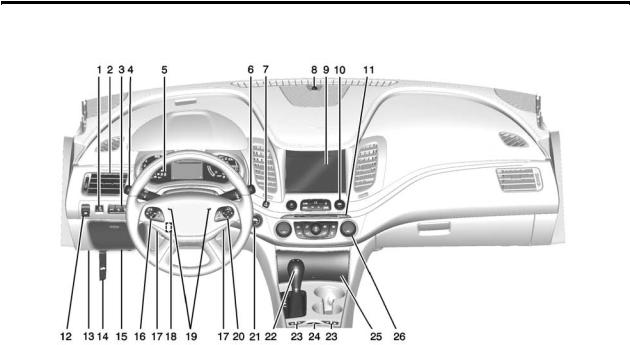
1-2 In Brief
Instrument Panel

In Brief |
1-3 |
1.Instrument Panel Illumination Control on page 6-4.
2.Air Vents on page 8-7.
3.Trunk Release. See Trunk on page 2-14.
Parking Assist Button. See
Assistance Systems for Parking or Backing on page 9-46 (If Equipped).
Lane Departure Warning (LDW) Button. See Lane Departure Warning (LDW) on page 9-54.
4.Turn Signal Lever. See Turn and Lane-Change Signals on
page 6-3.
5.Instrument Cluster on page 5-9.
Driver Information Center (DIC) on page 5-27.
6.Windshield Wiper/Washer on page 5-4.
7.Hazard Warning Flashers on page 6-3.
8.Light Sensor. See Automatic Headlamp System on page 6-2.
9.Storage Area with USB Port Inside (If Equipped). See
Instrument Panel Storage on page 4-1 and USB Port on page 7-14.
10.Infotainment on page 7-1.
11.CD Player on page 7-12.
12.Electric Parking Brake. See
Parking Brake on page 9-31.
13.Data Link Connector (Out of View). See Malfunction Indicator Lamp on page 5-17.
14.Hood Release. See Hood on page 10-4.
15.Instrument Panel Storage on page 4-1 (If Equipped).
Fuse Cover. See Instrument Panel Fuse Block on
page 10-40.
16.Cruise Control on page 9-35
(If Equipped).
Adaptive Cruise Control on page 9-37 (If Equipped).
Heated Steering Wheel on page 5-3 (If Equipped).
Forward Collision Alert (FCA) System on page 9-48 (If Equipped).
17.Steering Wheel Controls on page 5-3 (Out of View).
18.Steering Wheel Adjustment on page 5-2.
19.Horn on page 5-3.
20.Steering Wheel Controls on page 5-3.
Driver Information Center Buttons. See Driver Information Center (DIC) on page 5-27.
21.Ignition Positions (Keyless Access) on page 9-15 or Ignition Positions (Key Access) on page 9-17.
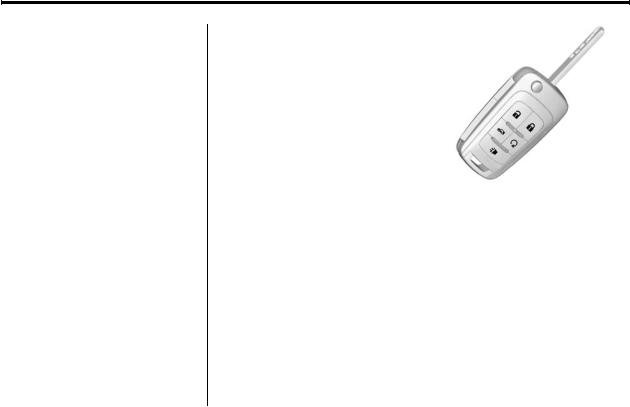
1-4 In Brief
22.Shift Lever. See Automatic Transmission on page 9-27.
23.Heated and Ventilated Seats on page 1-11 (If Equipped).
24.Traction Control/Electronic Stability Control on page 9-33.
25.Storage Area with Accessory Power Outlet Inside. See
Center Console Storage on page 4-2 and Power Outlets on page 5-6.
26.Climate Control Systems on page 8-1.
Dual Automatic Climate Control System on page 8-3.
Initial Drive
Information
This section provides a brief overview about some of the important features that may or may not be on your specific vehicle.
For more detailed information, refer to each of the features which can be found later in this owner manual.
Remote Keyless Entry
(RKE) System
The RKE transmitter may work up to 60 m (197 ft) away from the vehicle.
The RKE transmitter can have one of these two symbols for the remote trunk release.

In Brief |
1-5 |
With Remote Start Shown
Press the button to extend the key. The key can be used for all locks. This key is also used for the ignition, if the vehicle does not have pushbutton start.
K : Press to unlock the driver door or all doors.
Q : Press to lock all doors.
Lock and unlock feedback can be personalized.
V or Y: Press and hold to release the trunk.
7 : Press and release one time to initiate vehicle locator. Press and hold for at least three seconds to sound the panic alarm. Press again to cancel the panic alarm.
See Keys on page 2-1 and Remote Keyless Entry (RKE) System Operation on page 2-3.
Remote Vehicle Start
If equipped, the engine can be started from outside of the vehicle.
Starting the Vehicle
1.Aim the RKE transmitter at the vehicle.
2.Press and release Q.
3.Immediately, press and hold / for at least four seconds or until the turn signal lamps flash.
When the vehicle starts, the parking lamps will turn on and remain on as long as the engine is running. The doors will be locked and the climate control system may come on.
The engine will continue to run for 10 minutes. Repeat the steps for a 10-minute time extension. Remote start can be extended only once.
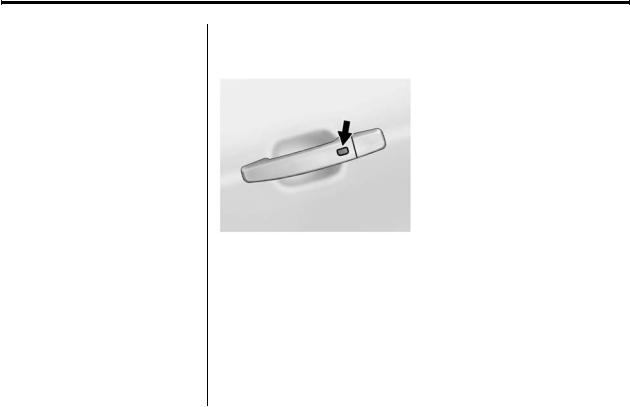
1-6 In Brief
Canceling a Remote Start
To cancel a remote start, do one of the following:
.Aim the RKE transmitter at the vehicle and press and hold / until the parking lamps turn off.
.Turn on the hazard warning flashers.
.Turn the vehicle on and then back off.
See Remote Vehicle Start on page 2-9.
Door Locks
Keyless Access
If equipped, use the Keyless Access system to lock and unlock the door. When the doors are locked and the Remote Keyless Entry (RKE) transmitter is within 1 m (3 ft) of the driver door handle, press the lock/ unlock button. When unlocking from the driver door, the first press unlocks that door; press again within five seconds to unlock all
passenger doors. See Remote Keyless Entry (RKE) System Operation on page 2-3.
This feature may be configured. See
Vehicle Personalization on page 5-40.
Key Cylinder Access
Use the key in the driver door. The key cylinder is covered by a cap. See Door Locks on page 2-10.
Inside the Vehicle
Push down on the door lock knob to lock that door. Pull once on the door handle to unlock the door and again to open the door. Press the power door lock switch to lock or unlock all doors. See Door Locks on
page 2-10 and Power Door Locks on page 2-12.

In Brief |
1-7 |
Power Door Locks
K : Press to unlock.
Q : Press to lock.
See Power Door Locks on page 2-12.
Trunk
To open the trunk:
.Press |on the driver door.
.Press and hold V or Yon the RKE transmitter.
.If equipped, press the touch pad on the underside of the trunk lid after unlocking all doors.
If equipped with Keyless Access, the RKE transmitter must be within 1 m (3 ft) of the trunk. Press the touch pad on the underside of the
trunk and lift to open. See Remote Keyless Entry (RKE) System Operation on page 2-3.
When closing the trunk, use the pull cup.
See Trunk on page 2-14.
Windows
The power windows only operate with the ignition in ACC/ ACCESSORY or ON/RUN/START, or when Retained Accessory Power
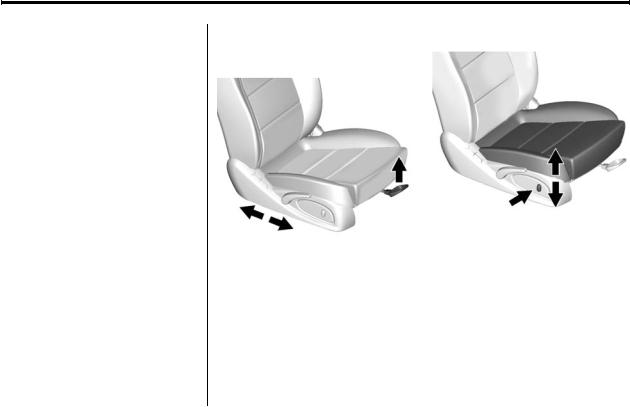
1-8 In Brief
(RAP) is active. See Retained Accessory Power (RAP) on page 9-24.
The power window switches on the driver door control all the windows. Each passenger door has a switch that controls only that window.
Press the switch to lower the window. Pull the switch up to raise it.
See Power Windows on page 2-21.
Seat Adjustment |
Seat Height Adjuster |
Manual Front Seats
To adjust a manual seat:
1.Pull the handle at the front of the seat.
2.Slide the seat to the desired position and release the handle.
3.Try to move the seat back and forth to be sure it is locked in place.
Press and hold the top or bottom of the switch to raise or lower the seat. Release the switch when the desired height is reached.
See Seat Adjustment on page 3-4.

In Brief |
1-9 |
Power Seats |
Lumbar Adjustment |
Reclining Seatbacks |
Manual Reclining Seatbacks
To adjust the seat:
.Move the seat forward or rearward by sliding the control forward or rearward.
.Raise or lower the front part of the seat cushion by moving the front of the control up or down.
.Raise or lower the seat by moving the rear of the control up or down.
See Power Seat Adjustment on page 3-5.
To adjust the lumbar support:
.Press and hold the control forward to increase or rearward to decrease lumbar support.
.Press and hold the control upward to raise or downward to lower the height of the lumbar support.
See Lumbar Adjustment on page 3-6.
To recline a manual seatback:
1.Lift the lever.
2.Move the seatback to the desired position, and then release the lever to lock the seatback in place.
3.Push and pull on the seatback to make sure it is locked.

1-10 |
In Brief |
To return the seatback to the upright position:
1.Lift the lever fully without applying pressure to the seatback, and the seatback will return to the upright position.
2.Push and pull on the seatback to make sure it is locked.
Power Reclining Seatbacks
To adjust a power seatback:
.Tilt the top of the control rearward to recline.
.Tilt the top of the control forward to raise.
See Reclining Seatbacks on page 3-6.
Memory Features
If equipped, the "1," "2," SET, and B (Exit) buttons on the driver door are used to manually save and recall memory settings for the driver seat, outside mirrors, and power tilt and telescoping steering column (if equipped).
See Memory Seats on page 3-7 and Vehicle Personalization on
page 5-40.
Second Row Seats
The rear seatbacks can be folded down to increase cargo space.
See Rear Seats on page 3-11.

In Brief |
1-11 |
Heated and Ventilated
Seats
Heated and Ventilated Seat
Buttons Shown, Heated Seat
Buttons Similar
If available, the buttons are on the center console. To operate, the ignition must be on.
I : If available, press to heat the driver or passenger seatback only.
J : Press to heat the driver or passenger seat cushion and seatback.
C: If available, press to ventilate the driver or passenger seat.
A ventilated seat has a fan that pulls or pushes air through the seat. The air is not cooled.
An indicator light on the button turns on when the heated or ventilated seat is on.
See Heated and Ventilated Front Seats on page 3-10.
Head Restraint
Adjustment
Do not drive until the head restraints for all occupants are installed and adjusted properly.
To achieve a comfortable seating position, change the seatback recline angle as little as necessary while keeping the seat and the head restraint height in the proper position.
See Head Restraints on page 3-2 and Seat Adjustment on page 3-4.
Safety Belts
Refer to the following sections for important information on how to use safety belts properly:
.Safety Belts on page 3-13.
.How to Wear Safety Belts Properly on page 3-14.
.Lap-Shoulder Belt on page 3-15.
.Lower Anchors and Tethers for Children (LATCH System) on page 3-41.
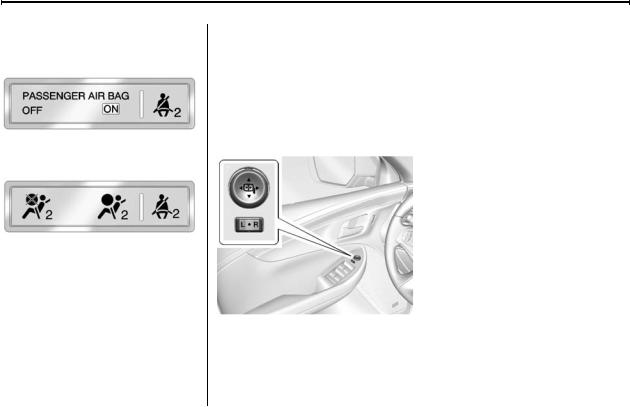
1-12 |
In Brief |
Passenger Sensing
System
United States
Canada
The passenger sensing system will turn off the front outboard passenger frontal airbag and knee airbag under certain conditions. No other airbag is affected by the passenger sensing system. See
Passenger Sensing System on page 3-27.
The passenger airbag status indicator lights on the overhead console when the vehicle is started. See Passenger Airbag Status Indicator on page 5-16.
Mirror Adjustment
Exterior Mirrors
1.Move the selector switch to L (Left) or R (Right) to choose the driver or passenger mirror.
2.Press one of the four arrows to move the mirror.
3.Move the selector switch to ) to deselect the mirror.
The vehicle has manual folding mirrors. See Folding Mirrors on page 2-20.
Interior Mirrors
Adjustment
Adjust the rearview mirror for a clear view of the area behind the vehicle.
Manual Rearview Mirror
For vehicles with a manual rearview mirror, push the tab forward for daytime use and pull it for nighttime use to avoid glare from the headlamps from behind. See
Manual Rearview Mirror on page 2-20.
Automatic Dimming Rearview
Mirror
For vehicles with an automatic dimming rearview mirror, the mirror will automatically reduce the glare from the headlamps from behind. The dimming feature comes on

In Brief |
1-13 |
when the vehicle is started. See
Automatic Dimming Rearview Mirror on page 2-20.
Steering Wheel
Adjustment
To adjust the steering wheel:
1.Pull the lever down.
2.Move the steering wheel up or down.
3.Pull or push the steering wheel closer or away from you.
4.Pull the lever up to lock the steering wheel in place.
Power Tilt Wheel
If equipped with this feature, press the control to move the steering wheel up and down or forward and rearward.
Do not adjust the steering wheel while driving.
Interior Lighting
Dome Lamps
The interior lamps control in the overhead console controls both the front and rear interior lamps.
To change the dome lamp settings, press the following:
OFF: Turns the lamp off, even when a door is open.
DOOR: The lamp comes on automatically when a door is opened.

1-14 |
In Brief |
ON: Turns the lamp on.
Reading Lamps
Front Reading Lamps
Rear Reading Lamps
There are front and rear reading lamps in the overhead console and the headliner.
# or $ : Press the button near each lamp to turn it on or off.
Exterior Lighting
The exterior lamp control is on the turn signal lever.
There are four positions.
O : Turns off the exterior lamps. The knob returns to the AUTO position after it is released. Turn to O again to reactivate the
AUTO mode.
AUTO: Automatically turns the exterior lamps on and off, depending on outside lighting.
; : Turns on the parking lamps including all lamps, except the headlamps.

In Brief |
1-15 |
2 : Turns on the headlamps together with the parking lamps and instrument panel lights.
See:
.Exterior Lamp Controls on page 6-1
Windshield Wiper/Washer
With the ignition in ACC/ ACCESSORY or ON/RUN/START, move the lever to select the wiper speed.
HI: Use for fast wipes.
LO: Use for slow wipes.
INT: Move the lever up to INT for intermittent wipes, then turn the x INT band up for more frequent wipes or down for less frequent wipes.
OFF: Use to turn the wipers off.
8 : For a single wipe, briefly move the lever down. For several wipes, hold the lever down.
n L : Pull the lever toward you to spray windshield washer fluid and activate the wipers.
See Windshield Wiper/Washer on page 5-4.

1-16 |
In Brief |
Climate Controls
The heating, cooling, and ventilation for the vehicle can be controlled with these systems.
|
|
Climate Control System |
|
1. |
Fan Control |
5. |
Temperature Control |
2. |
Air Conditioning |
6. |
Recirculation |
3. |
Air Delivery Modes |
7. |
Rear Window Defogger |
4. |
Defrost |
|
|

In Brief |
1-17 |
Dual Automatic Climate Control System
1.Driver and Passenger Temperature Controls
2.Air Conditioning or Comfort/Eco Air Conditioning (eAssist Only)
3.Fan Control
4.Defrost
5.AUTO (Automatic Operation)
6.Recirculation
7.Air Delivery Modes
8.On/Off (Fan)
9.Rear Window Defogger
10.SYNC
See Climate Control Systems on page 8-1 or Dual Automatic Climate Control System on page 8-3 (if equipped).
Transmission
Driver Shift Control (DSC)
This feature allows for changing gears similar to a manual transmission. To use this feature:
1.Move the shift lever from D (Drive) rearward to
M (Manual Mode).
2.Using the button on the top of the shift lever, press the + (plus) end of the button to upshift,
or press the − (minus) end of the button to downshift.
See Manual Mode on page 9-29.

1-18 |
In Brief |
Vehicle Features
Radio(s)
O : Press to turn the system on. Press and hold to turn it off. When on, press to mute; press again to unmute. Turn to increase or decrease the volume.
RADIO: Press to choose between FM, AM, and SiriusXM®,
if equipped.
MEDIA: Press to change the audio source between CD, USB, SD card, and AUX.
{ : Press to go to the Home Page.
MENU: Press to select a menu.
g : Press to seek the previous station or track.
l : Press to seek the next station or track.
See Overview on page 7-3 about these and other radio features.
Storing Radio Station Presets
Up to 25 preset stations from all bands can be stored in the favorite lists in any order. Up to five stations can be stored in each favorite page and the number of favorite pages can be set.
To store the station to a position in the list, while on the active source main page, such as AM, FM,
or SiriusXM (if equipped), press and hold a Favorites/Soft Key button on the faceplate.
See “Storing Radio Station Presets” under AM-FM Radio on page 7-7.
Setting the Clock
See Clock (Base Radio) on
page 5-5 or Clock (Uplevel Radio) on page 5-5.
Satellite Radio
Vehicles with a SiriusXM® satellite radio tuner and a valid SiriusXM satellite radio subscription can receive SiriusXM programming.
SiriusXM Satellite Radio
Service
SiriusXM is a satellite radio service based in the 48 contiguous United States and 10 Canadian provinces. SiriusXM satellite radio has a wide variety of programming and commercial-free music, coast to coast, and in digital-quality sound. A fee is required to receive the SiriusXM service.
For more information refer to:
.www.siriusxm.com or call 1-866-635-2349 (U.S.).
.www.xmradio.ca or call 1-877-209-0079 (Canada).
See Satellite Radio on page 7-9.
Portable Audio Devices
This vehicle has a 3.5 mm (1/8 in) auxiliary input jack and USB port in the center console. If equipped with storage behind the radio, there is a USB port inside. See Instrument Panel Storage on page 4-1. External devices such as iPods®,

In Brief |
1-19 |
laptop computers, MP3 players, CD changers, and USB storage devices may be connected, depending on the audio system.
See USB Port on page 7-14 and Auxiliary Jack on page 7-17.
Bluetooth®
The Bluetooth® system allows users with a Bluetooth-enabled cell phone to make and receive hands-free calls using the vehicle audio system and controls.
The Bluetooth-enabled cell phone must be paired with the in-vehicle Bluetooth system before it can be used in the vehicle. Not all phones will support all functions.
See Bluetooth (Infotainment Controls) on page 7-20 or Bluetooth (Voice Recognition) on page 7-24 or Bluetooth (Overview) on page 7-18.
Steering Wheel Controls
Some audio controls can be adjusted at the steering wheel.
g : For vehicles with OnStar® or a Bluetooth® system, press to interact with those systems. See OnStar Overview on page 14-1 or
“Bluetooth (Overview)” in the infotainment manual.
c : Press to reject an incoming call, or end a current call. Press to mute or unmute the infotainment system when not on a call.
The favorite and volume switches are on the back of the steering wheel.
1.Favorites: Press to select the next or previous favorite.
2.Volume: Press to increase or decrease the volume.
See Steering Wheel Controls on page 5-3.
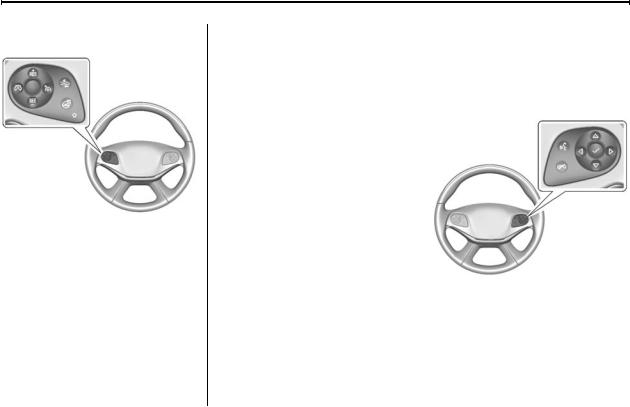
1-20 |
In Brief |
Cruise Control
5 : Press to turn cruise control on or off. A white indicator comes on in the instrument cluster.
+RES: Press briefly to make the vehicle resume to a previously set speed, or press and hold to accelerate. If cruise control is already active, use to increase vehicle speed.
SET–: Press briefly to set the speed and activate cruise control. If cruise control is already active, use to decrease vehicle speed.
* : Press to disengage cruise control without erasing the set speed from memory.
See Cruise Control on page 9-35 or Adaptive Cruise Control on
page 9-37 (if equipped).
Infotainment System
The base radio information is included in this manual, if equipped. See the infotainment manual for information on the uplevel radios, audio players, phone, navigation system, and voice or speech recognition. There is also information on settings and downloadable applications (if equipped).
Driver Information
Center (DIC)
The DIC display is in the instrument cluster. It shows the status of many vehicle systems.
w or x : Press to move up or down in a list, or on the main view press to cycle through the different Info app pages.
o or p : Press o to open application menus on the left. Press p to open interaction menus on the right.

In Brief |
1-21 |
V : Press to select a menu item. Press and hold to reset values on certain screens, or on the main view reset info pages to the original setting.
See Instrument Cluster on page 5-9 and Driver Information Center (DIC) on page 5-27.
Forward Collision Alert
(FCA) System
If equipped, FCA is intended to help avoid or reduce the harm caused by front-end crashes. FCA provides a green indicator when a vehicle is detected directly ahead. It provides a flashing visual alert and beeps when approaching a vehicle directly ahead too quickly. FCA also provides a visual alert if following another vehicle much too closely.
See Forward Collision Alert (FCA) System on page 9-48.
Lane Departure
Warning (LDW)
If equipped, LDW is intended to help avoid unintentional lane departures at speeds of 56 km/h (35 mph) or greater. LDW uses a camera sensor to detect the lane markings. The
LDW indicator, @, appears green if a lane marking is detected. If the vehicle departs the lane, the indicator will change to amber and flash. In addition, beeps will sound.
See Lane Departure Warning (LDW) on page 9-54.
Side Blind Zone
Alert (SBZA)
If equipped, SBZA will detect vehicles in the next lane over in the vehicle's side blind zone area. When this happens, the SBZA display will light up in the corresponding outside side mirror and will flash if the turn signal is on.
See Side Blind Zone Alert (SBZA) on page 9-52.
Rear Vision
Camera (RVC)
If equipped, RVC displays a view of the area behind the vehicle, on the center stack display, when the vehicle is shifted into R (Reverse).
See Assistance Systems for Parking or Backing on page 9-46.
Ultrasonic Parking Assist
If equipped, Ultrasonic Rear Parking Assist (URPA) uses sensors on the rear bumper to assist with parking and avoiding objects while in
R (Reverse). It operates at speeds less than 8 km/h (5 mph). URPA may display a warning triangle on the Rear Vision Camera screen and a graphic on the instrument cluster to provide the object distance. In addition, multiple beeps or pulses may occur if very close to an object.
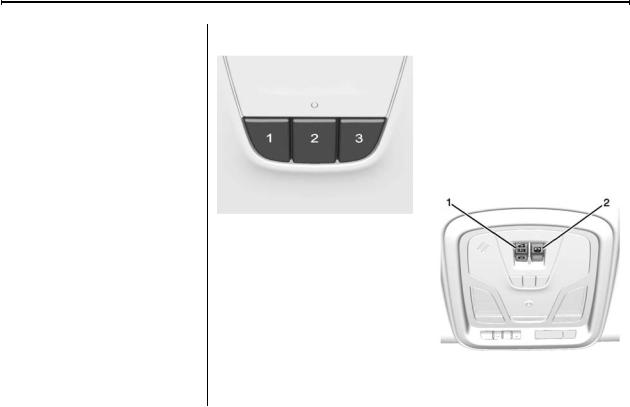
1-22 |
In Brief |
See Driver Assistance Systems on page 9-45.
Power Outlets
The accessory power outlets can be used to plug in electrical equipment, such as a cell phone or MP3 player.
The vehicle has three accessory power outlets:
.Inside the front storage area below the climate control system.
.Inside the center console.
.On the rear of the center console.
Lift the cover to access the accessory power outlet.
See Power Outlets on page 5-6.
Universal Remote System
This system provides a way to replace up to three remote control transmitters used to activate devices such as garage door openers, security systems, and home automation devices.
Read the instructions completely before attempting to program the Universal Remote system. Because of the steps involved, it may be helpful to have another person available to assist with programming the Universal Remote system.
See Universal Remote System on page 5-46.
Sunroof
If equipped, the ignition must be in ON/RUN or ACC/ACCESSORY, or in Retained Accessory Power (RAP) to operate the sunroof and power sunshade. See Retained Accessory Power (RAP) on
page 9-24.
1.~ Sunroof Switch
2.Q Sunshade Switch

In Brief |
1-23 |
Sunroof Switch
Open/Close: Press and hold the front or rear of ~ to open or close
the sunroof. Release ~ at the desired position to stop movement.
Vent Feature: Press the front or rear of ~ to the first detent to open and close the vent feature. The sunshade partially opens and closes automatically during the vent operation.
Express Open/Express Close:
Fully press and release the front or rear of ~. The sunroof opens and closes automatically.
Sunshade Switch
Open/Close: Press and hold the front or rear of Q to open or close the sunshade to the desired position.
Express Open/Express Close:
Fully press and release the front or rear of Q to express open or express close the sunshade. If the sunroof is open, the sunshade will express close just short of the open sunroof.
See Sunroof on page 2-23.
eAssist Features
eAssist® Overview
If the vehicle has eAssist, there are several additional features that contribute to increased efficiency.
Vehicles with eAssist have an automatic engine start/stop feature. This feature saves fuel by shutting the engine off when the vehicle is stopped. When the engine shuts off automatically, all the accessories will continue to operate normally. In very hot or cold conditions, the engine will only shut off automatically part of the time. See
Starting the Engine on page 9-19.
There are two air conditioning settings available. The comfort setting maximizes cabin comfort. The eco setting maximizes efficiency allowing more frequent, and longer engine stops than the comfort setting. See Dual Automatic Climate Control System on
page 8-3.

1-24 |
In Brief |
eAssist vehicles have a Hill Start Assist (HSA) feature, which may be useful when the vehicle is stopped on a grade. See Hill Start Assist (HSA) on page 9-33.
Vehicles with eAssist have a slightly different instrument cluster, which includes an AUTO STOP indicator on the tachometer. See Instrument Cluster on page 5-9.
The eAssist system uses a high voltage battery, which is cooled with air drawn from the vehicle interior.
The cold air intake for the battery is behind the rear seat, on the filler panel. Do not cover the intake. See
Battery on page 10-27.
High Voltage Safety
Information
Vehicles with eAssist have a standard 12-volt battery and a high voltage battery. Only a trained service technician with the proper knowledge and tools should inspect, test, or replace the high voltage battery. See your dealer if the high voltage battery needs service.
In emergency situations, first responders can cut the two clearly labeled cut points in the engine compartment to disable the high voltage battery and air bag systems
— do not cut the high voltage cable.
Automatic Engine Start/
Stop Feature
Vehicles with eAssist have an automatic engine start/stop feature. After the engine is started and has reached operating temperature, the auto stop feature may cause the engine to turn off when the brake pedal is applied and the vehicle comes to a complete stop. When the brake pedal is released, or the accelerator pedal is applied, the engine will restart. The engine will continue to run until the next
auto stop.
To restart the engine during the auto stop, release the brake pedal or press the accelerator pedal. The engine starts immediately. The vehicle continues to run until the next stop.
AUTO STOP on the tachometer signifies that the engine is in auto stop mode. See Tachometer on page 5-13 for more information.
A chime will sound when the driver door is opened while in auto stop
